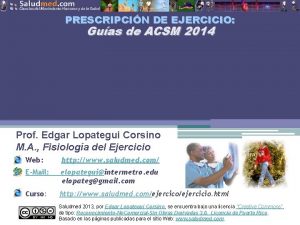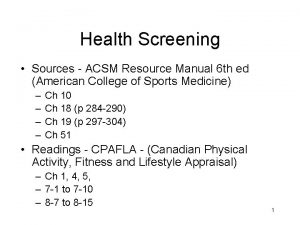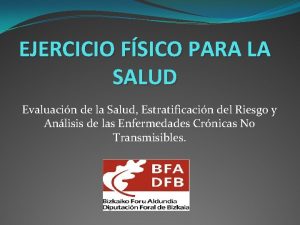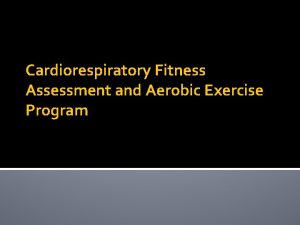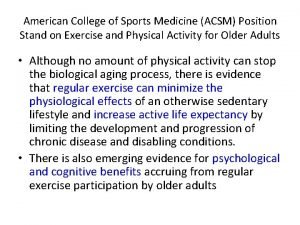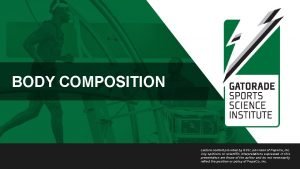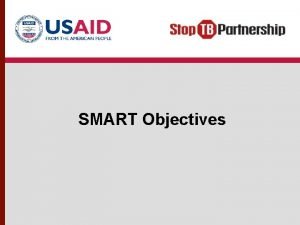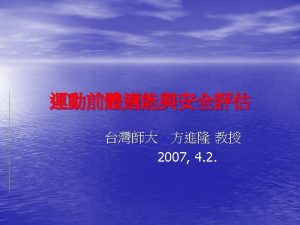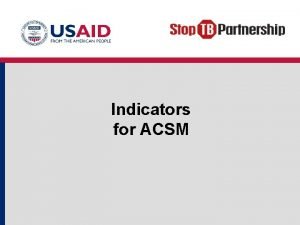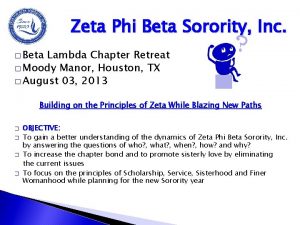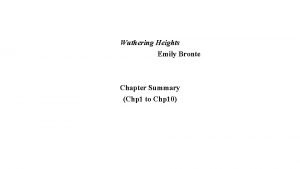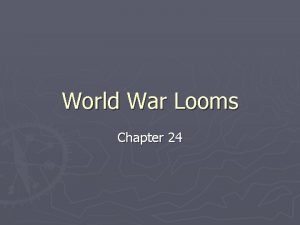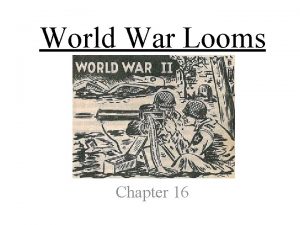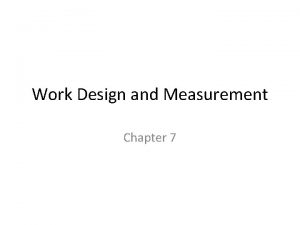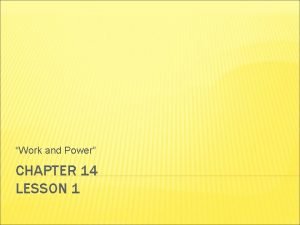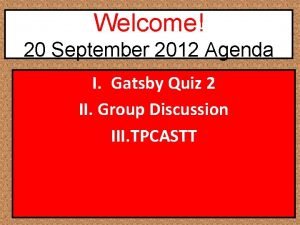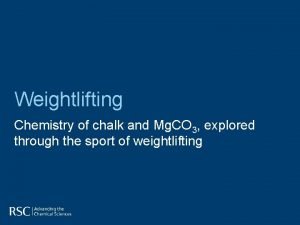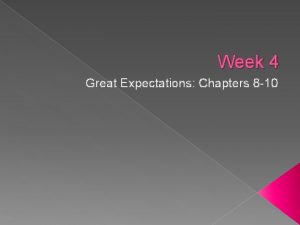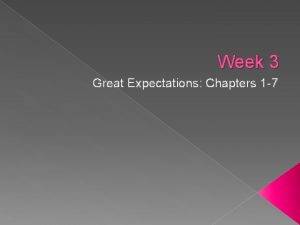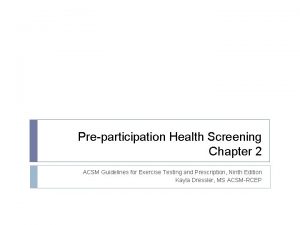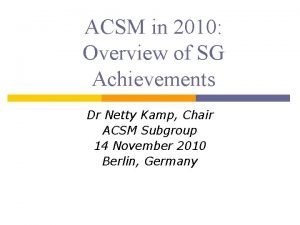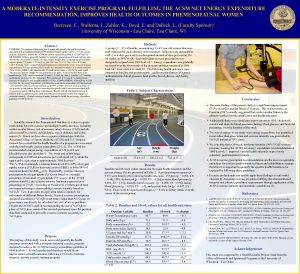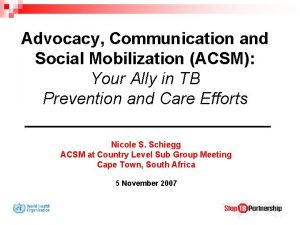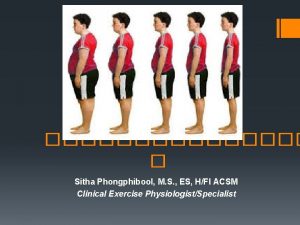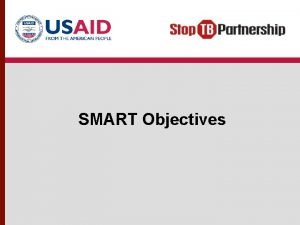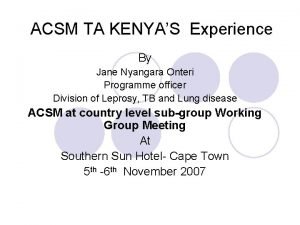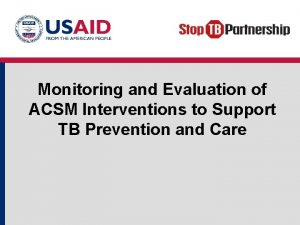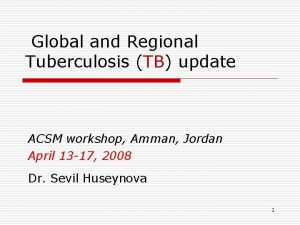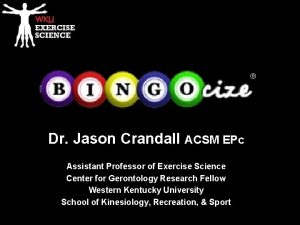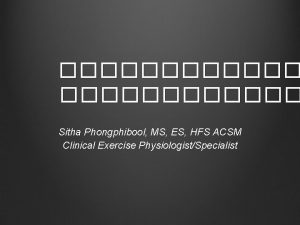ACSM Chapter 2 Chapter 3 Chapter 11 Chapter




























































- Slides: 60


ACSM Chapter 2 • Chapter 3 Chapter 11 • Chapter 4 • Chapter 5 • Chapter 10

ﻭﺭﺯﺵ ﻭ ﻣﺪیﺮیﺖ ﻭﺯﻥ What is exercise? • What is physical activity?

ﻭﺭﺯﺵ ﻭ ﻣﺪیﺮیﺖ ﻭﺯﻥ What is the role of exercise in weight loss?

DIABETES MELLITUS and preparticipation Examination • Indications for Symptom Limited Exercise Testing • Individuals with diabetes and at least one of the following: Age > 35 yr Type 1 for > 10 yr duration or Type 2 diabetes for > 15 yr duration Any additional cardiovascular risk factor Microvascular disease evidenced by proliferative retinopathy or nephropathy including microabluminuria • Autonomic dysfunction • •

DIABETES MELLITUS and preparticipation Examination • CBC Diff • BUN & Cr • Chol & TG • FBS & HBA 1 c • 25 OH vit D 3 • Physical exam and foot exam & HTN • Exercise test • Body composition & BMI • Eyes test

PAR _Q (Physical Activity Readiness Questionnaire ) • 1. Has your doctor ever said that you have a heart condition and that you should only do physical activity recommended by a doctor? • 2. Do you feel pain in your chest when you do physical activity? • 3. In the past month, have you had chest pain when you were not doing physical activity? • 4. Do you lose your balance because of dizziness or do you ever lose consciousness? • 5. Do you have a bone or joint problem (for example, back, knee or hip) that could be made worse by a change in your physical activity? • 6. Is your doctor currently prescribing drugs (for example, water pills) for your blood pressure or heart condition? • 7. Do you know of any other reason why you should not do physical activity?






ﻭﺭﺯﺵ ﻭ ﻣﺪیﺮیﺖ ﻭﺯﻥ Energy systems • ATP_PC ( Phosphagen System) • Anaerobic Glycolysis • Aerobic


ﻭﺭﺯﺵ ﻭ ﻣﺪیﺮیﺖ ﻭﺯﻥ ATP_PC ( Phosphagen System) Adenosine ATP P ADP Pi


ﻭﺭﺯﺵ ﻭ ﻣﺪیﺮیﺖ ﻭﺯﻥ • ATP + H. 2. O → ADP + Pi. ATPase. 7, 000 to 12, 000 calories • Coupled Reaction • ATP + H 2 O ←→ ADP + Pi • ATPase • ADP + C~P ←→ ATP + C • Creatine kinase

ﻭﺭﺯﺵ ﻭ ﻣﺪیﺮیﺖ ﻭﺯﻥ Calorie • The small calorie (symbol: cal) is the approximate amount of energy needed to raise the temperature of one gram of water by one degree Celsius. • The large calorie, kilogram calorie, (symbol: Cal, equiv: kcal) is the amount of energy needed to raise the temperature of one kilogram of water by one degree Celsius. The large calorie is thus equal to 1000 small calories or one kilocalorie (symbol: kcal)


ﻭﺭﺯﺵ ﻭ ﻣﺪیﺮیﺖ ﻭﺯﻥ Anaerobic Glycolysis Glucose ATP NADH Pyruvate Lactate


ﻭﺭﺯﺵ ﻭ ﻣﺪیﺮیﺖ ﻭﺯﻥ Glucose NADH ATP Pyruvate Anaerobic Lactate Aerobic Acetyl-co. A Krebs



ﻭﺭﺯﺵ ﻭ ﻣﺪیﺮیﺖ ﻭﺯﻥ metabolic equivalent (MET) • One metabolic equivalent (MET) is defined as the amount of oxygen consumed while sitting at rest and is equal to 3. 5 ml O 2 per kg body weight x min. • 1 MET = the energy (oxygen) used by the body at rest, MET, is defined as the ratio of a person's metabolic rate during an activity relative to their basal resting metabolic rate, METS show the intensity of an activity. One MET equals the energy spent sitting still • • Activity that burns 3 to 6 METs is considered moderate-intensity physical activity. • • Activity that burns > 6 METs is considered vigorous-intensity physical activity.

ﻭﺭﺯﺵ ﻭ ﻣﺪیﺮیﺖ ﻭﺯﻥ Physical activity MET Light intensity activities sleeping watching television writing, desk work, typing walking, 1. 7 mph (2. 7 km/h), level ground, strolling, very slow walking, 2. 5 mph (4 km/h) Moderate intensity activities bicycling, stationary, 50 watts, very light effort walking 3. 0 mph (4. 8 km/h) calisthenics, home exercise, light or moderate effort, general walking 3. 4 mph (5. 5 km/h) bicycling, <10 mph (16 km/h), leisure, to work or for pleasure bicycling, stationary, 100 watts, light effort Vigorous intensity activities jogging, general calisthenics (e. g. pushups, situps, pullups, jumping jacks), heavy, vigorous effort running jogging, in place rope jumping <3 0. 9 1. 0 1. 8 2. 3 2. 9 3 to 6 3. 0 3. 3 3. 5 3. 6 4. 0 5. 5 >6 7. 0 8. 0 10. 0

ﻭﺭﺯﺵ ﻭ ﻣﺪیﺮیﺖ ﻭﺯﻥ VO 2 max • VO 2 max (also maximal oxygen consumption, maximal oxygen uptake, peak oxygen uptake or maximal aerobic capacity) is the maximum capacity of an individual's body to transport and use oxygen during incremental exercise or maximal or exhaustive exercise. • VO 2 max= Q ( Ca O 2 – Cv O 2 ), when these values are obtained during an exertion at a maximal effort. where Q is the cardiac output of the heart, Ca. O 2 is the arterial oxygen content, and Cv. O 2 is the venous oxygen content. • (Ca. O 2 – Cv. O 2) is also known as the arteriovenous oxygen difference.

ﻭﺭﺯﺵ ﻭ ﻣﺪیﺮیﺖ ﻭﺯﻥ VO 2 max • Accurately measuring VO 2 max involves a physical effort sufficient in duration and intensity to fully tax the aerobic energy system. In general clinical and athletic testing, this usually involves a graded exercise test (either on a treadmill or on a cycle ergometer) in which exercise intensity is progressively increased while measuring ventilation and oxygen and carbon dioxide concentration of the inhaled and exhaled air. VO 2 max is reached when oxygen consumption remains at steady state despite an increase in workload

ﻭﺭﺯﺵ ﻭ ﻣﺪیﺮیﺖ ﻭﺯﻥ VO 2 max • Cooper test in which the distance covered running in 12 minutes is measured. • where d 12 is distance (in metres) covered in 12 minutes

ﻭﺭﺯﺵ ﻭ ﻣﺪیﺮیﺖ ﻭﺯﻥ VO 2 max • Another estimate of VO 2 max, based on maximum and resting heart rates.

ﻭﺭﺯﺵ ﻭ ﻣﺪیﺮیﺖ ﻭﺯﻥ walking treadmill VO 2= (0. 1 x S m/min) + (1. 8 x S m/min x G) + 3. 5 S= speed G= grade Running treadmill VO 2= (0. 2 x S m/min) + (0. 9 x S m/min x G) + 3. 5 Arm Ergometer Equation VO 2= (18 x watts) / kg + 3. 5 ACSM Leg Ergometer Equation : VO 2= [ (1. 8 x work rate (kgm/min) ) / body mass (kg) ]+(7) VO 2= [ (10. 8 x watts) / body mass (kg) ]+ (7) ACSM Stepping Equation VO 2= (0. 2 x stepping rate) + (1. 33 x 1. 8 x step height in meters x rate) + 3. 5





ﻭﺭﺯﺵ ﻭ ﻣﺪیﺮیﺖ ﻭﺯﻥ VO 2 max in Men Fitness Level Age Group 20 -29 30 -39 40 -49 50 -59 60 -69 Low <38 <34 <30 <25 <21 Somewhat Low 39 -43 35 -39 31 -35 26 -31 22 -26 Average 44 -51 40 -47 36 -43 32 -39 27 -35 High 52 -56 48 -51 44 -47 40 -43 36 -39 Very High >57 >52 >48 >44 >40

ﻭﺭﺯﺵ ﻭ ﻣﺪیﺮیﺖ ﻭﺯﻥ VO 2 max in Women Fitness Level Age Group 20 -29 30 -39 40 -49 50 -65 Low <28 <27 <25 <21 Somewhat Low 29 -34 28 -33 26 -31 22 -28 Average 35 -43 34 -41 32 -40 29 -36 High 44 -48 42 -47 41 -45 37 -41 Very High >49 >48 >46 >42

FITT F: Frequency I: Intensity T: Time T: Type

Frequency This is how often per week one will perform the exercise. Plan on most days of the week

Intensity This is how hard one exercises. Moderate effort is appropriate Intensity of Exercise : The intensity of exercise for an apparently healthy individual is usually between 40 % - 85 % of their VO 2 max or its equivalent in heart rate which is 55 % - 90 % of maximal heart rate.

Time This is the duration of each session. Start off with as little as needed. The ACSM recommends 20 to 60 minutes of continuous aerobic activity.

Type This is the choice of physical activity, which can include recreational activities and domestic or occupational activities.

Warm up & cool down & Progressive

Components Warm-up 2 -10 minutes Cool Down 2 -10 minutes Conditioning 20 -60 minutes Optimal goal Flexibility and Resistance Training




RPE (rating of perceived exertion )

Target heart rate formula • Max heart rate= 220 - age • Target Heart Rate = (%)*MHR


Karvonen formula. • • Max heart rate= 220 - age Rest Heart rate Reserve Heart rate= (MHR –Rest HR) Target heart rate = % Reserve HR + Rest HR

Mr. Mohamadi just had a maximum symptom limited graded exercise stress test with the following data : • • Age =40 Resting Heart Rate Before The GXT = 70 bpm Maximum Symptom Limited Heart Rate Achieved = 160 bpm What is Target heart rate ? (With 60% RHR) MHR=220 -40=180 THR=0. 6*180= 108 MHR=220 -40=180 THR=0. 6*(180 -70)+70 THR=136 THR=0. 6*(160 -70)+70 THR= 124

• METs = VO 2 max / 3. 5 • WALKING VO 2 (ml/kg/min) = [SPEED (m/min)*. 1]+[SPEED (m/min)* GRADE *1. 8]+3. 5 ml/kg/min • RUNNING VO 2 (ml/kg/min) = [SPEED (m/min)*. 2]+[SPEED (m/min)* GRADE *. 9]+3. 5 ml/kg/min • kcal/min = [METs × 3. 5 × kg body weight]/200). • 1 Kcal = 4. 2 k j 7000 Kcal = 1 kg


• For example, • the energy (caloric) expenditure of a 70 -kg individual at a prescribed 6 -MET capacity is calculated as (6 × 3. 5 × 70 kg)/200, which equals 7. 35 kcal/min (30. 87 k. J/min). • 7000 Kcal / 7. 35 = 952 min • 952 / 7 day = 136 min





 Acsm 2014
Acsm 2014 Acsm risk factors
Acsm risk factors Ecnts
Ecnts Acsm guidelines
Acsm guidelines Heel raise
Heel raise Acsm waist to hip ratio chart
Acsm waist to hip ratio chart Acsm smart goals
Acsm smart goals Risk stratification
Risk stratification Acsm roles
Acsm roles Summary of the red tent
Summary of the red tent Chapter 8 and 9 summary great gatsby
Chapter 8 and 9 summary great gatsby Chapter 10 chemical reactions
Chapter 10 chemical reactions Chapter 11 assessment chemistry
Chapter 11 assessment chemistry Chapter 9 chemical reactions study guide
Chapter 9 chemical reactions study guide Means and extremes of proportions
Means and extremes of proportions Chapter 6: career readiness
Chapter 6: career readiness 7 ionic and metallic bonding
7 ionic and metallic bonding Chapter 9 surface water answer key
Chapter 9 surface water answer key Chapter 2 assessment physics principles and problems
Chapter 2 assessment physics principles and problems The central science 14th edition
The central science 14th edition Chapter 7 ionic and metallic bonding assessment answer key
Chapter 7 ionic and metallic bonding assessment answer key Chapter 4 population ecology test answer key
Chapter 4 population ecology test answer key Chapter 2 standardized test practice answers
Chapter 2 standardized test practice answers Facts about the philippian jailer
Facts about the philippian jailer Ionic compounds properties
Ionic compounds properties Chapter 7 chapter assessment ionic compounds and metals
Chapter 7 chapter assessment ionic compounds and metals Dichlorine octoxide formula
Dichlorine octoxide formula Zeta phi beta membership intake process manual
Zeta phi beta membership intake process manual Working with young children chapter 1
Working with young children chapter 1 Chapter 5 summary wuthering heights
Chapter 5 summary wuthering heights Wuthering heights chapter 8
Wuthering heights chapter 8 Chapter 10 qualitative research designs
Chapter 10 qualitative research designs Chapter 16 building vocabulary world war looms
Chapter 16 building vocabulary world war looms Chapter 16 building vocabulary world war looms
Chapter 16 building vocabulary world war looms World war 1 and the russian revolution chapter 27
World war 1 and the russian revolution chapter 27 Lesson 4 world war 1 ends
Lesson 4 world war 1 ends Chapter 17 section 3 world history
Chapter 17 section 3 world history Chapter 32 assessment world history
Chapter 32 assessment world history Chapter 30 section 2 world history
Chapter 30 section 2 world history Chapter 8 nationalist revolutions sweep the west
Chapter 8 nationalist revolutions sweep the west Chapter 15 section 2 world history
Chapter 15 section 2 world history Chapter 10 section 2 central america and the caribbean
Chapter 10 section 2 central america and the caribbean Ap human geography chapter 11 vocab
Ap human geography chapter 11 vocab World geography chapter 3 climates of the earth
World geography chapter 3 climates of the earth Work measurement techniques
Work measurement techniques Unit 14 lesson 1 drivers ed
Unit 14 lesson 1 drivers ed Woodwork joints names
Woodwork joints names Chapter 9 adhesives gluing and clamping answer key
Chapter 9 adhesives gluing and clamping answer key Wilson fights for peace section 4
Wilson fights for peace section 4 Why study financial markets and institutions chapter 1
Why study financial markets and institutions chapter 1 Why be happy when you could be normal themes
Why be happy when you could be normal themes Where the red fern grows chapter 9 questions and answers
Where the red fern grows chapter 9 questions and answers Ap psychology chapter 14
Ap psychology chapter 14 Great gatsby chapter 7-9 quiz
Great gatsby chapter 7-9 quiz Is chalk natural or manmade
Is chalk natural or manmade Great expectations chapter 20 summary
Great expectations chapter 20 summary Great expectations chapter 4
Great expectations chapter 4 Great expectations chapter 10
Great expectations chapter 10 Great expectations summary chapter 4
Great expectations summary chapter 4 Matthew chapter 7
Matthew chapter 7 Chapter 20 weather patterns and severe storms
Chapter 20 weather patterns and severe storms
